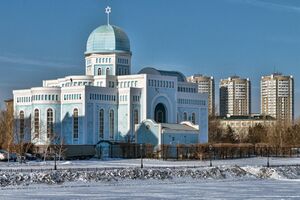Zorfashazi
יהודי מזרח | |
|---|---|
 Dom Dode Central Synagogue | |
| Total population | |
| 3,500.000 (2025) | |
| Regions with significant populations | |
| Daxia | 3,480,000 |
| Levantia | 20,000 |
| Languages | |
| Jaddish, Daxian | |
| Religion | |
| Judaism | |
Zorfashazi Jews, also known as Eastern Jews, Dom Dode Jews or simply Zorfashazim, are a Jewish diaspora population who coalesced as a distinct community in Daxia in the 13th century.
The traditional diaspora language of Zorfashazi Jews is Jaddish (a hebrew language which incorporates several dialects), with Hebrew used only as a sacred language until relatively recently. Throughout their time in Daxia, the Zorfashazi have made many important contributions to philosophy, scholarship, literature, art, music, and science.
Zorfashazi originate from the Jewish refugees from Audonia who were taken in by the Qian dynasty and settled in the Pachin valley, in central Daxia . There they became a distinct diaspora community with a unique way of life that adapted traditions from their homeland to their new environment. The Zorfashazi religious community enjoyed imperial protection and developed in several Daxian towns within Pachin. The city of Dom Dode is the principal center of the community and houses the largest synagogue in the country.
History
Originating in Audonia thousands of years ago, Judaism and its followers would fall under the shadow of Oduniyyad rule. Curtailed in their rights and freedoms as dhimmi, the jews persisted for many years until the ascent of Caliph Ruwaid. Ruwaid ordered the start of terrible persecutions of non muslims. Killings, ransacking of synagogues and forced conversions were inflicted on jews all across the caliphate. The High Priest Shimon of Bardabeh appealed to the greatest enemy of the caliph for help, the emperor of the Qian dynasty.
At the end of the Third Oduniyyad-Qian war, the victorious Emperor Fanqie included among his conditions for peace, a demand to be given the jews over as subjects. The exact phrasing has survived in historical texts and is as follows: that the cruel Arab who is blind in one eye by zealotry, pass unto me the Jews from his care so that my realm will benefit from the work of their minds, their hands and their hearts. What remained of the Jews in the eastern parts of the caliphate then journeyed to Daxia under the leadership of Shimon of Bardabeh, being settled in then uninhabited lands in the Pachin valley. Approximately seven thousand jews in total were settled in that first period. Intermarriage with ethnic Daxian was forbidden by imperial decree, which suited the community just fine as the jews wanted to preserve their bloodline and the Emperor wanted them isolated and dependent on his personal patronage.
The Great Edict of Protection of 1242 was promulgated by Emperor Fanqie of the Qian dynasty to establish over the Zorfashazi Jews, the protection of the state. Fanqie and his successors saw the jewish migrants fleeing the arabs as an useful asset as craftsmen and scholars. In accordance with the edict, Zorfashazi Jews could not, on the basis of their strange faith and uncharacteristic physical traits(for Daxians), be bothered in their person, be deprived of their property or have their religious rituals obstructed or be forcibly converted away from Judaism. Jews could however be tried in Daxian courts and the protections of the edict would be withdrawn from convicted criminals.
The edict further established that jews of the Zorfashazi sect could ply any trade, but only within the Pachin valley. Furthermore they could only establish settlements of their own or open synagogues within said geographic region. The edict was in force until the end of imperial rule, and the new republican government enshrined the equality of Daxians in the new constitution, ending the edicts restrictions.
Rites
The Zorfashazim have maintained several ancient judaic traditions such as being led by High Priests as their highest religious authority. They ritually slaughter lambs during Passover and celebrated the traditional holy days of Yom Kippur, Rosh Hashanah, Shavuot, Sukkot, Hanukkah, Purim and Tisha B'Av. The Sabbath was assiduously observed until the 1960's when the government began cracking down on religious practice. From then on Sabbath was more or less ignored until the relaxation of the law in 2011.
Aspects of Daxian ancestor worship were incorporated over time into their rituals, as the Dom Dode Central Synagogue has an annex where past High Priests are memorialized and commemorated with ritual offerings.
Notable Zorfashazi Jews
-
Avidor Boruch also known as Wang Ming. Served as Director of the Imperial Observatory in the Qian period.
-
Benson Salomons, sole Jewish member of the People's Assembly.
-
Meyer Rozik, dwarf folk singer.
-
High Priest Eshel Abimelech.



